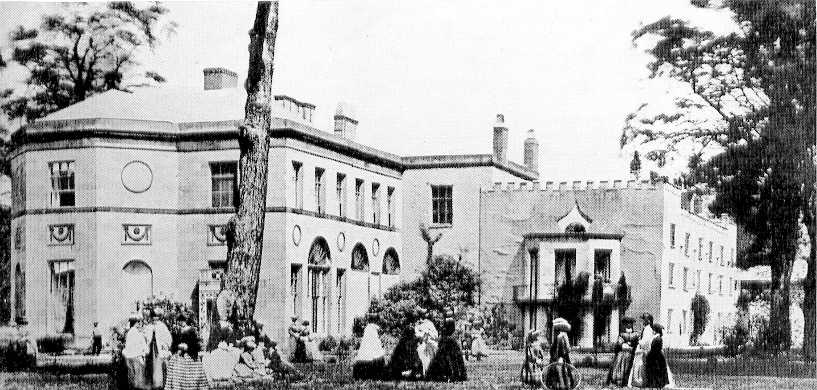| The Trademark and the Poultry House |
| It had long been the tradition that the Crescent Trade Mark of Brunner, Mond & Co. was inspired by the old Poultry House [built by the then owner, Lord Penrhyn] at Winnington Hall. This was a semi-circular building which stood where the Research Laboratory did, later, and was considered a local 'wonder' once upon a time. An alternative theory was that 'Mond' in German means 'Moon', which may have inspired Ludwig Mond to draw up the design with John Brunner. The original Trade Mark appears to have been designed, and stencils and seals made by Mr. C.G. Walmsley, of Lord Street, Liverpool, to whom Mr Brunner sent sketches on 5th November, 1873. The Poultry House, however, was 'a very interesting building'. A newspaper cutting was sent to the 'Alkali News' by the daughter of Mr Pimblott, he having once been Head Gardener at Winnington Hall, where he lived in the Poultry House:- A Palatial Poultry House. In a work called 'Practical Agriculture,' by R.W. Dickson, M.D., published in 1805, is a description of a poultry house on Lord Penrhyn's estate at Winnington, Cheshire. The writer of the article goes on- From what is stated it is evident that the building in question was much finer than the Royal poultry house in Windsor Great Park, which is still standing, or that at Haddo, Scotland, erected by the Marquis of Aberdeen. No one would claim that any of these could be economic, but were intended to add to the amenities of the respective estates. It consists of a handsome, regular front, extending about 140 feet ; at each extremity is a neat pavilion with a large arched window. These pavilions are united to the centre of the design by a colonnade of small cast-iron pillars, painted white, which support a cornice and a slate roof, covering a paved walk and a variety of conveniences for the poultry, for keeping eggs, corn, etc. The doors into these are all of lattice work, also painted white, and the framing green. In the middle of the front, are four handsome stone columns and four pilasters supporting likewise a cornice and a slate roof, under which and between the columns is a beautiful mosaic iron gate ; on one side of this gate is an elegant little parlour, beautifully papered and furnished, and at the other end of the colonnade a very neat kitchen, so excessively clean and in such high order that it is delightful to view it. This front is the diameter or chord of a large semi-circular court behind, round which there is also a colonnade, and a great variety of conveniences for the poultry. This court is neatly paved, with a circular pond and a pump in the middle of it. The whole fronts towards a rich little field or paddock, called the poultry paddock, in which the poultry have liberty to walk about between meals. At one o'clock a bell rings, and the beautiful gate in the centre is opened. The poultry being then mostly walking in the paddock, and knowing by the sound of the bell that their repast is ready for them, fly and run from all corners, and rush in at the gate, everyone striving to get the first share in the scramble. About 600 poultry of different kinds were kept, and although so large a number, the semi-circular court is kept so neat and clean that not a speck of dung was to be seen. This poultry place was built of brick, excepting the pillars and cornices, the lintels and the jambs of the doors and windows, but the bricks are not seen, being covered with a remarkably fine kind of slate from his Lordship's estate in Wales. These slates are closely jointed and fastened with screw nails on small spars fixed to the brick; they are afterwards painted and fine white sand thrown on while the paint is wet, which gives the whole an appearance of the most beautiful freestone." |
 |
 |
 |
| Another view of Winnington Hall during it's time as a Ladies' Boarding School, run by the Misses Bell. |
| The crescent shaped Poultry House (right) [from an 1899 map] |